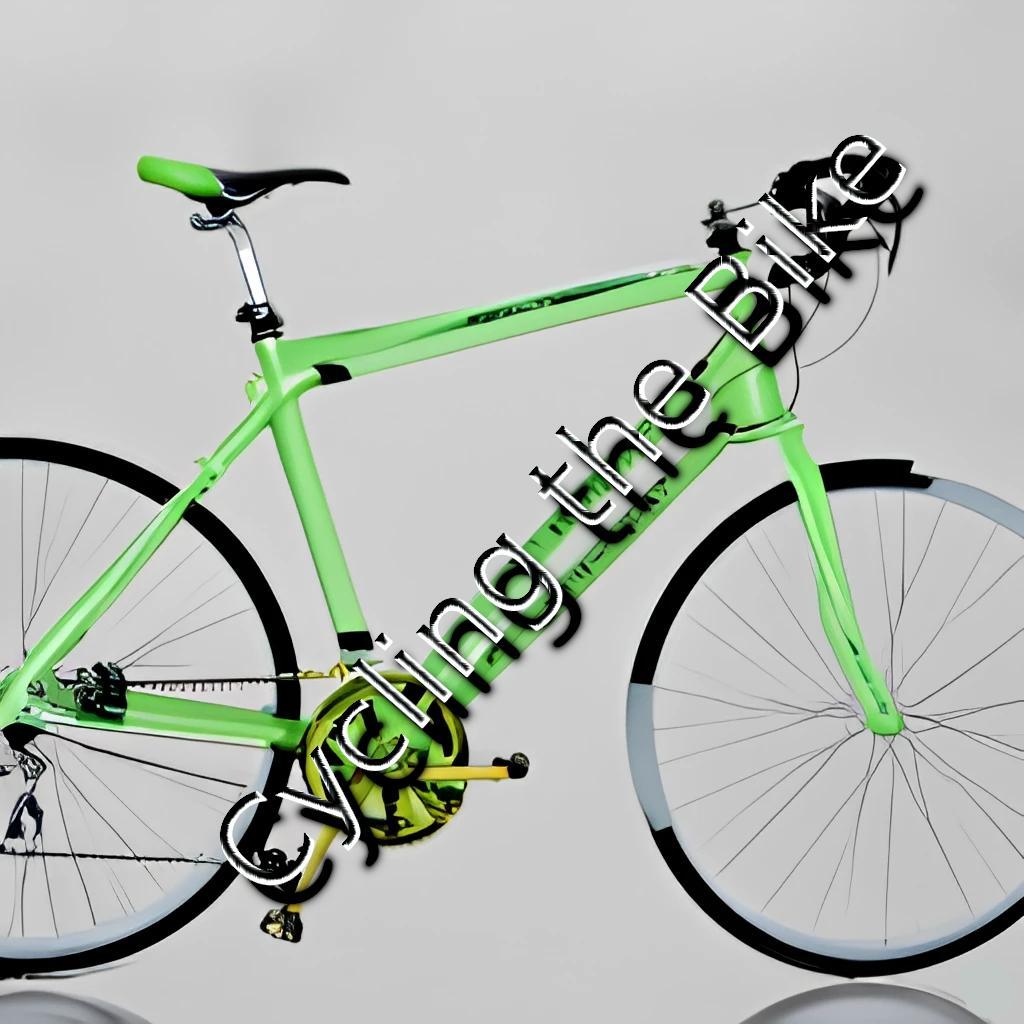


In the elegant simplicity of the bicycle, a scientific symphony unfolds, harmonizing human kinetics, materials engineering, and aerodynamics. Beyond being a mode of transport, the bicycle represents a convergence of biomechanics, physics, and cutting-edge materials that propel riders forward. Let's embark on a journey into the scientific intricacies that make bicycles not just a means of movement, but a testament to the marriage of human effort and technological innovation.
Biomechanics in Motion: The Human-Powered Engine
At the heart of cycling lies the fascinating biomechanical dance between the human body and the bicycle. Scientists delve into the physics of pedaling, studying muscle activation, joint angles, and force distribution to optimize the efficiency of human-powered locomotion. From the synchronization of muscles in the pedal stroke to the ergonomic design of handlebars and saddles, the marriage of biomechanics and cycling science ensures a harmonious partnership between rider and machine.
Materials Engineering: Crafting the Perfect Frame
The bicycle frame, a work of art and engineering marvel, is a canvas for materials scientists. The choice of materials, whether lightweight alloys, robust carbon composites, or traditional steel, is a delicate balance between strength, weight, and durability. Advances in materials engineering contribute to frames that offer optimal stiffness for power transfer while absorbing road vibrations for a smooth ride—a testament to the marriage of form and function.
Aerodynamics: Cutting Through the Air with Precision
The sleek silhouette of a racing cyclist slicing through the air is a testament to the scientific exploration of aerodynamics. Engineers employ wind tunnel testing, computational fluid dynamics, and biomechanical modeling to minimize drag and optimize rider positioning. From streamlined helmets to aerodynamic wheel designs, each component undergoes scrutiny to reduce resistance and enhance the efficiency of human-powered propulsion.
Gear Ratios and Mechanical Advantage: Engineering Efficiency
Behind the simplicity of a bicycle's gear system lies a complex application of mechanical principles. Scientists and engineers meticulously calculate gear ratios, considering factors such as pedal force, cadence, and terrain gradients. The result is a mechanical advantage that optimizes energy transfer, allowing cyclists to navigate diverse landscapes with efficiency—a triumph of physics in the realm of human mobility.
Smart Materials and Bike Tech: Enhancing the Riding Experience
In the age of smart technology, bicycles are not exempt from the digital revolution. The integration of smart materials, sensors, and electronic components contributes to a futuristic cycling experience. From electronically controlled suspension systems to adaptive gear shifting, the fusion of science and technology elevates the bicycle from a mechanical marvel to an intelligent, responsive companion for riders.
Physiology and Endurance: Pushing Human Limits
Scientific inquiry extends to the physiological aspects of cycling, exploring the limits of human endurance and performance. Sports scientists study factors such as oxygen consumption, heart rate variability, and muscle fatigue to optimize training regimens for cyclists. This scientific approach to human performance not only enhances athletic achievements but also contributes valuable insights into the broader field of exercise physiology.
Safety Innovations: Protecting Riders on the Road
The safety of cyclists is a focal point of scientific innovation. Researchers delve into materials science to create robust helmets that provide effective impact protection. Technological advancements such as smart helmets with built-in communication systems and visibility features enhance the safety of cyclists on the road. The scientific pursuit of cyclist safety is a testament to the commitment to creating a secure environment for riders.
Sustainable Cycling: Pedaling towards a Greener Future
The bicycle, in its simplicity, emerges as a powerful tool for sustainable transportation. Scientists advocate for cycling as a low-impact, eco-friendly mode of mobility that reduces carbon emissions and promotes a healthier lifestyle. The scientific discourse on sustainable urban planning often includes the integration of cycling infrastructure, recognizing the bicycle as a solution for both environmental conservation and public health.
Today, there are more people than ever before who own bicycles, and as a result, there is a growing demand for innovations in the world of cycling. Here are a few perspectives on potential future innovations for bicycle owners:
Electric bikes: Electric bikes, or e-bikes, are already becoming more popular, but there is still room for innovation in this area. One possibility is the development of lighter and more efficient batteries, which would allow for a longer range and more power.
Smart bikes: With the rise of the Internet of Things (IoT), there is the potential for bicycles to become smarter and more connected. For example, smart bikes could include features such as GPS tracking, automatic lighting, and integration with smartphone apps for navigation and performance tracking.
Safety innovations: There are many potential safety innovations that could benefit bicycle owners, such as improved visibility through the use of advanced lighting or reflector technology, or the development of smart helmets that include features such as automatic emergency calling and impact detection.
Sustainable materials: As environmental concerns continue to grow, there is an increasing interest in sustainable materials for bicycle frames and components. Innovations in this area could include the development of new materials such as bamboo or recycled plastics, or the use of advanced manufacturing techniques to reduce waste and energy consumption.
Cycling and bikes have become an increasingly popular mode of transportation and a popular pastime for people around the world. Here are some ways that cycling and bikes have impacted our lives:
Health and fitness: Cycling is a great form of exercise and can help improve overall health and fitness. Regular cycling can help improve cardiovascular health, strengthen muscles, and boost mood and mental health.
Sustainable transportation: Bikes are an environmentally friendly mode of transportation that can help reduce carbon emissions and traffic congestion. Many cities around the world have implemented bike-sharing programs and bike-friendly infrastructure to encourage more people to bike instead of drive.
Convenience and cost-effectiveness: Bikes are a cost-effective and convenient mode of transportation that can help people save money on gas and parking fees. They are also a great way to avoid traffic and get around quickly in urban areas.
Community and social connection: Cycling and biking clubs and groups are a great way to connect with other people who share your passion for cycling. These communities offer opportunities for group rides, events, and socializing with other cyclists.
Personal challenge and achievement: Cycling and biking can be challenging and rewarding activity that offers a sense of achievement and accomplishment. Completing a challenging bike ride or race can provide a sense of pride and accomplishment.
E-bikes, or electric bicycles, have become increasingly popular in recent years and have had a significant impact on our lives in several ways:
Sustainable transportation: E-bikes are an environmentally friendly mode of transportation that can help reduce carbon emissions and traffic congestion. They are a great alternative to traditional gas-powered vehicles and can help people reduce their carbon footprint.
Health and fitness: While e-bikes provide an electric assist, they still require physical effort from the rider. Riding an e-bike can be a great way to get exercise and improve cardiovascular health.
Accessibility: E-bikes can make cycling more accessible to people who may not be able to ride a traditional bike due to physical limitations. The electric assist can help people overcome physical challenges and enjoy the benefits of cycling.
Cost-effectiveness: E-bikes can be a cost-effective mode of transportation, particularly for people who live in urban areas. They are cheaper than cars to purchase and maintain and can help people save money on gas and parking fees.
Convenience: E-bikes offer a convenient and quick way to get around urban areas, particularly during rush hour when traffic is heavy. They are also easier to park and maneuver in tight spaces than cars.
Bicycles transportation.
There have been many advancements in bicycle holders in recent years, aimed at improving the safety and convenience of transporting bicycles.
One of the most popular innovations is the hitch-mounted bike rack. These racks are mounted onto the back of a vehicle's hitch receiver and can hold multiple bicycles securely. They are often adjustable to fit different sizes of bikes and can be tilted down to allow for easy access to the trunk or rear hatch of the vehicle.
Another popular option is the roof-mounted bike rack. These racks are mounted onto the roof of a vehicle and can hold one or more bikes securely. They are often adjustable to fit different sizes of bikes and can be easily removed when not in use.
In addition, there are now several types of bike holders that attach to the trunk or rear of a vehicle. These holders use straps to secure the bikes in place and can be adjusted to fit different sizes of bikes.
There are also innovative designs that make it easier to transport electric bikes, which can be heavier and bulkier than traditional bicycles. For example, some bike racks have integrated ramps or lift mechanisms to help with loading and unloading.
The advancements in bicycle holders have made it easier and safer to transport bicycles, allowing more people to enjoy the outdoors on their bikes.
Bicycle maintenance is an essential part of keeping your bike in good condition and ensuring safe and smooth rides. Here are some important aspects of bicycle maintenance:
Cleaning: Regular cleaning of your bike helps to prevent the buildup of dirt, grime, and debris, which can damage components over time. Use a soft-bristled brush, mild soap, and water to clean your bike, and make sure to dry it thoroughly afterward.
Lubrication: Lubrication is crucial for keeping your bike's moving parts working smoothly and preventing wear and tear. Apply lubricant to your chain, derailleur pulleys, and other moving parts regularly, and wipe off any excess.
Tire pressure: Proper tire pressure is important for maintaining good handling and reducing the risk of flats. Check your tire pressure regularly and inflate them to the recommended pressure listed on the tire sidewall.
Brakes: Brake maintenance is crucial for safety. Check your brake pads regularly and replace them if they are worn. Adjust your brake cables if necessary, and make sure your brakes are working correctly before each ride.
Drivetrain: The drivetrain, which includes the chain, cassette, and derailleurs, is one of the most important parts of your bike. Keep your chain clean and well-lubricated, and replace it if it shows signs of wear. Check your derailleur alignment regularly and adjust it if necessary.
Frame and components: Inspect your bike's frame and components regularly for signs of wear, damage, or corrosion. Replace any worn or damaged parts, and make sure that all bolts are tightened to the recommended torque specifications.
Checking your bicycle regularly is an essential part of bicycle maintenance. Here are some critical things to check on your bike:
Brakes: Check that your brakes are working correctly and that the brake pads are not worn down. Make sure that the brake cables are tight and not frayed.
Tires: Check your tires for signs of wear, such as cuts or bulges, and make sure that they are inflated to the recommended pressure listed on the sidewall.
Chain: Check your chain for signs of wear, such as stretching or rust. Make sure that it is lubricated and running smoothly.
Wheels: Check that your wheels are true (not warped) and that the spokes are tight. Make sure that the quick-release levers or thru-axles are tightened securely.
Handlebars and stem: Check that your handlebars are straight and secure and that the stem is tight.
Pedals: Check that your pedals are tight and not loose.
Shifters and derailleurs: Check that your shifters are working correctly and that the derailleurs are shifting smoothly.
Frame and components: Inspect your bike's frame and components regularly for signs of wear, damage, or corrosion.
By checking these critical things regularly, you can help to ensure that your bicycle is safe and ready for any ride. If you notice any issues, it's essential to have them addressed promptly by a professional mechanic.
The bicycle, a seemingly uncomplicated invention, unfurls as a scientific marvel that intertwines the complexities of biomechanics, materials engineering, and aerodynamics. Cyclists become the conductors of this scientific symphony, harmonizing with their two-wheeled companions to propel themselves forward with elegance and efficiency. As technology and human ingenuity continue to propel the evolution of bicycles, the open road becomes a canvas for the ongoing scientific exploration of mobility—a journey where the rhythmic pedaling of cyclists echoes the heartbeat of progress.
Have a good ride,

We use cookies
We use cookies and other tracking technologies to improve your browsing experience on our website, to show you personalized content and targeted ads, to analyze our website traffic, and to understand where our visitors are coming from. Privacy Policy.